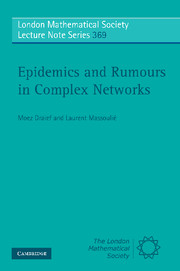8 - Epidemics on general graphs
Published online by Cambridge University Press: 25 January 2011
Summary
Introduction
In this chapter we investigate the behaviour of two classical epidemic models on general graphs. We consider a closed population of n individuals, connected by a neighbourhood structure that is represented by an undirected, labelled graph G = (V, E) with node set V = {1, …, n} and edge set E. Each node can be in one of three possible states: susceptible (S), infective (I) or removed (R). The initial set of infectives at time 0 is assumed to be non empty, and all other nodes are assumed to be susceptible at time 0. We will focus on two classical epidemic models: the susceptible-infected-removed (SIR) and susceptible-infected-susceptible (SIS) epidemic processes.
In what follows we represent the graph by means of its adjacency matrix A, i.e. aij = 1 if (i, j) ∈ E and aij = 0 otherwise. Since the graph G is undirected, A is a symmetric, non-negative matrix, all its eigenvalues are real, the eigenvalue with the largest absolute value ρ is positive and its associated eigenvector has non-negative entries (by the Perron–Frobenius theorem). The value ρ is called the spectral radius. If the graph is connected, as we shall assume, then this eigenvalue has multiplicity one, the corresponding eigenvector is strictly positive and is the only one with all elements non-negative.
- Type
- Chapter
- Information
- Epidemics and Rumours in Complex Networks , pp. 87 - 107Publisher: Cambridge University PressPrint publication year: 2009



